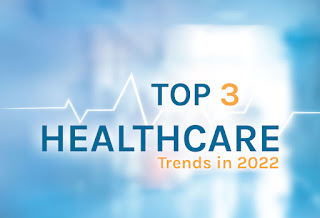By: Lotfi Al-Sarori
The healthcare industry is growing rapidly. Revenue of the healthcare industry was estimated at 2.7 trillion USD in 2021 according to Statista. Moreover, the global digital health market, valued at 175 billion USD in 2019, is expected to reach around 660 billion USD by 2025.
With this growth, there are a few industry trends that we have been witnessing during the past years. Some of these trends are picking up the pace and starting to materialize in a larger scale. Three of these are expected to become major healthcare motifs in 2022. They are discussed in the next sections.
Patient-Centricity
Patients are naturally at the centre of healthcare services. However, what we mean here is that we are seeing a shift towards patient-centricity, similar to the concept of customer-centricity in other business sectors. Healthcare providers are realizing that patients today are demanding quicker response, more accessibility, and better quality of service. This is what a recent Forbes article about 2022 healthcare trends referred to as consumerization.
Patients, the service consumers in this case, are becoming the main driver of how healthcare services should be delivered, where, and for how much. They are inquiring about the why and what regarding the services they are getting. Today, patients are asking more questions about their healthcare charges, the type of exams they are given, and the diagnosis they are provided. Patients are gaining more control of their healthcare services and are now more empowered.
This empowerment has resulted in healthcare service providers seeking ways to satisfy their consumers, the patients. For example, pharmacy retailers in the US, such as CVS and Walgreens, are starting to provide primary care services to patients at their locations. This gives patients the convenience of buying any needed medications at the spot where they are getting their treatment. They can also conveniently get their groceries from the same place while they are at it.
Digitalization
The healthcare trend towards consumerism, is pressuring healthcare institutions to digitalize further. Digital transformation can enable healthcare institutions meet the increasing patient demand for timely and better services. For example, virtual health is becoming more common, especially as a result of the pandemic. Information technology is making this possible like in the case of telemedicine.
Healthcare is already experiencing a major digital transformation. Patient information and medical records are already digital in the form of EHR. HIS software is automating the patient journey from clinics, pharmacies, labs and radiology to inpatient management and operating theatres. Web portals are providing secure access to patients, providers, and payers, helping them to collaborate in harmony to provide the best services to patients in a timely manner. Moreover, Cloud-based healthcare systems are enabling secure 24/7 access and support to all healthcare stakeholders from anywhere. Furthermore, digital health apps are becoming increasingly popular. Healthcare mobile apps are used by patients to receive and fill their prescriptions electronically and keep up to date on their relevant information and details.
Analytics
Data analytics is an essential tool no matter what sector you are in. In healthcare, it can provide valuable insights in many aspects. Healthcare providers can utilize the large amount of patient data to find patterns and check for abnormalities related to certain diseases, relevant treatments, medical exams, medications, etc. Analytics can be used to find ways to improve treatment plans, recommend effective medications, determine the best way to provide patient care, and deliver customizable patient services. In addition, using the huge amount of data generated during a pandemic, data analytics can provide insight into patterns related to social behaviour, medical responses, effectiveness of treatments, and more. This information can be used to better handle pandemics and improve the wellbeing of people.
In the example of CVS and Walgreens mentioned above, these retailers already have a huge amount of information about their consumers. Analytics can provide these retailers with a lot of useful information to help them better target their customers and provide them with superb service. Consumer behaviour can be analysed to find ways to improve customer service and adjust product sizes, packaging, and availability based on customer demands.
In Summary
There are three main trends we expect to see gaining more momentum this year. Consumerization, or consumerism, where healthcare institutions are yielding control to their patients is a main trend. Patient satisfaction is becoming the foremost aspiration to many healthcare organizations similar to customer satisfaction in consumer markets. In addition, digitalization in healthcare is going beyond the desired to becoming a necessity to cope with and survive the high demand for better and timely services. Furthermore, analytics offers the necessary knowledge to improve patient care, create more effective treatments, and customize services based on patient needs.
To find out what ESKADENIA Software has to offer in healthcare, please check out ESKADENIA’s healthcare systems for hospitals, clinics, labs, pharmacies, and radiology centres.



No comments:
Post a Comment